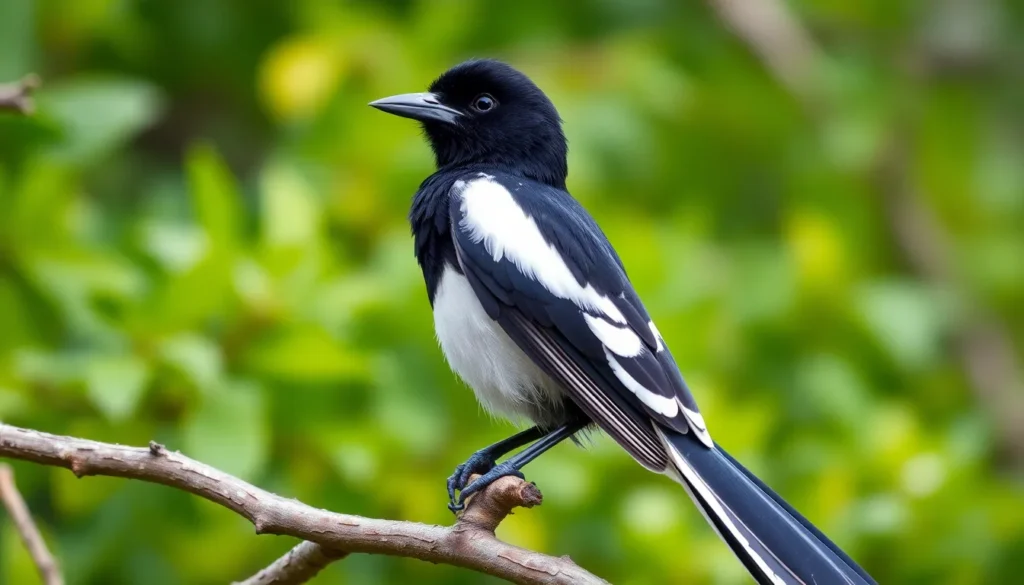Magpies captivate us with their striking black-and-white plumage and remarkable intelligence that rivals some of the industry’s smartest animals. These bold corvids have earned their place as one of nature’s most fascinating creatures through their complex social behaviors problem-solving abilities and distinctive chattering calls that echo across continents.
We’ve discovered that magpies possess cognitive skills that’ll surprise you—they can recognize themselves in mirrors use tools to solve puzzles and even hold elaborate “funerals” for their deceased. Their reputation as clever opportunists isn’t just folklore; it’s backed by scientific research that continues to reveal new depths of their mental capabilities.
From the Australian magpie’s melodious warbling to the Eurasian magpie’s mischievous antics these birds have woven themselves into human culture and mythology for centuries. Whether you’re a seasoned birdwatcher or simply curious about wildlife we’ll explore what makes magpies such extraordinary members of the avian industry.
Physical Characteristics of the Magpie Bird
Magpie birds possess distinctive physical traits that make them instantly recognizable among corvid species. We observe remarkable variations in their appearance across different regions while maintaining their signature elegant build.
Size and Build
Magpie birds measure between 17 to 23 inches in length with wingspans reaching 20 to 24 inches across. Males typically weigh 5.1 to 7.4 ounces while females range from 4.1 to 5.8 ounces. Their bodies feature long graduated tails that comprise nearly half their total length.
These birds display robust builds with strong legs adapted for ground foraging. We notice their heads appear proportionally large compared to their sleek bodies. Magpie birds possess powerful straight bills measuring 1.3 to 1.8 inches long that serve multiple functions from food gathering to nest construction.
Distinctive Black and White Plumage
Magpie bird plumage creates striking contrasts through bold black and white coloration patterns. Their heads, necks, breasts and shoulders display deep black coloring while wings show brilliant white patches. We observe iridescent blue-green sheens across their black feathers when sunlight hits at exact angles.
White markings extend across their bellies and flanks creating dramatic visual appeal. Primary flight feathers remain predominantly black with white bases visible during flight displays. Tail feathers exhibit glossy black coloration with metallic purple and green highlights that shift based on lighting conditions.
| Plumage Feature | Color Description | Location |
|---|---|---|
| Head and neck | Deep black with blue-green iridescence | Upper body |
| Breast | Pure white | Front torso |
| Wings | Black with white patches | Flight surfaces |
| Belly | Bright white | Lower torso |
| Tail | Black with purple-green metallic sheen | Rear appendage |
Regional Variations in Appearance
Eurasian magpie birds show subtle size differences across their range from Western Europe to Eastern Asia. Scandinavian populations tend to be larger than their Mediterranean counterparts by approximately 8 to 12 percent. We document tail length variations of up to 2 inches between northern and southern European subspecies.
North American black-billed magpies display slightly different proportions with longer tails relative to body size compared to their Eurasian relatives. Korean magpie birds feature more extensive white patches on their wings and backs than other Asian populations. Australian magpie birds represent entirely different species even though their common name, showing predominantly black plumage with distinctive white markings that vary by geographic location.
Habitat and Geographic Distribution

Magpie birds occupy diverse habitats across multiple continents with remarkable adaptability. Their distribution patterns reveal fascinating insights into how these intelligent corvids thrive in various environments worldwide.
Natural Range and Territory
Magpie species establish territories spanning vast geographic regions across four continents. Eurasian magpies (Pica pica) inhabit the largest range extending from western Europe through central Asia to eastern China and parts of North Africa. North American black-billed magpies (Pica hudsonia) occupy territories throughout western North America from Alaska to New Mexico.
Australian magpies (Gymnorhina tibicen) dominate the entire Australian continent and southern New Guinea. These territorial birds maintain year-round territories ranging from 2 to 20 hectares depending on habitat quality and food availability. Breeding pairs defend their territories vigorously against intruders using complex vocalizations and aerial displays.
Each magpie species demonstrates distinct territorial preferences within their geographic ranges. European populations favor agricultural landscapes mixed with woodland edges while North American varieties select riparian areas near rivers and streams. Territory size varies significantly based on resource density with urban populations maintaining smaller territories than rural counterparts.
Preferred Environmental Conditions
Magpies thrive in semi-open landscapes combining trees for nesting with open ground for foraging. Optimal habitats feature scattered woodland areas adjacent to grasslands parks or agricultural fields. These adaptable birds prefer elevations below 3000 feet but some populations inhabit mountain regions up to 8000 feet.
Temperature ranges suitable for magpies extend from -40°F in northern territories to 100°F in southern regions. Rainfall requirements vary by species with most populations tolerating annual precipitation between 10 to 60 inches. European magpies adapt to temperate climates while Australian species handle more arid conditions.
Urban environments increasingly attract magpie populations due to abundant food sources and nesting opportunities. City-dwelling magpies modify their behavior patterns adapting to human activity schedules and artificial lighting. Suburban areas with mature trees and open lawns provide ideal conditions supporting high population densities.
| Environmental Factor | Preferred Range | Adaptation Strategy |
|---|---|---|
| Elevation | 0-3000 feet | Territory modification |
| Temperature | -40°F to 100°F | Behavioral adjustment |
| Rainfall | 10-60 inches annually | Foraging adaptation |
| Habitat Type | Semi-open woodland | Flexible nesting sites |
Behavior and Social Structure
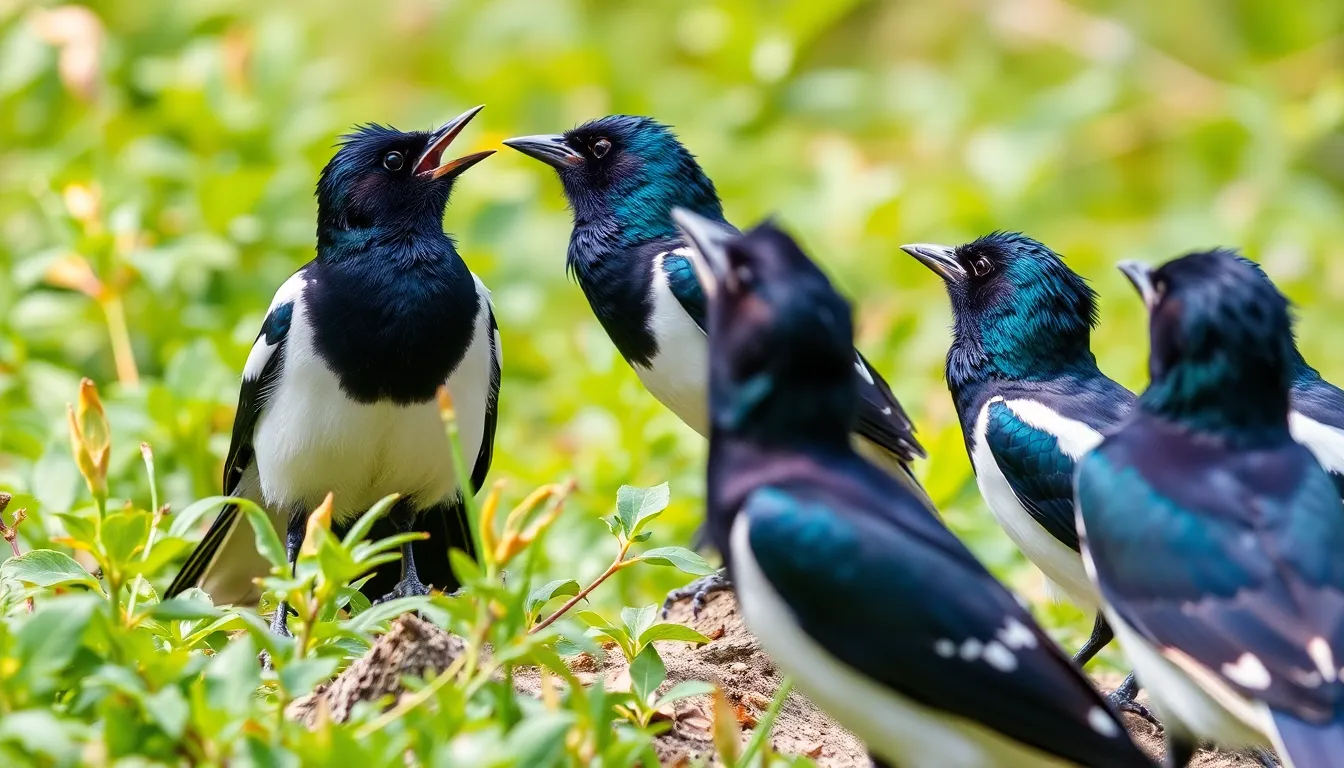
Magpie social dynamics reveal complex behavioral patterns that demonstrate their cognitive sophistication and collaborative nature. We observe intricate hierarchical systems within magpie communities that govern everything from territory disputes to cooperative breeding arrangements.
Intelligence and Problem-Solving Abilities
Magpies rank among the most intelligent bird species on Earth, demonstrating cognitive abilities that rival those of great apes. These corvids solve multi step puzzles by breaking down complex problems into manageable components. Research conducted at Cambridge University shows magpies completing tasks requiring up to 8 sequential steps to reach a food reward.
Mirror self recognition tests reveal magpies as one of only 5 non mammalian species capable of recognizing their own reflection. Scientists place colored stickers on magpie throats during these experiments, and the birds consistently attempt to remove the foreign objects only when viewing themselves in mirrors. Tool use behaviors include fashioning wire probes to extract insects from tree bark crevices and using stones to crack open hard shelled prey.
Problem solving scenarios demonstrate magpies’ ability to plan future actions and understand cause and effect relationships. Captive magpies learn to operate mechanical devices within 3 to 5 attempts, showing remarkable spatial memory and logical reasoning capabilities.
Communication and Vocalizations
Magpie communication systems cover over 20 distinct vocalizations that serve exact social functions within their communities. Territorial calls consist of harsh chattering sequences lasting 15 to 30 seconds, warning neighboring groups about boundary violations. Alarm calls feature sharp staccato notes repeated 8 to 12 times when predators like hawks or cats approach nesting areas.
Contact calls between mated pairs include soft warbling sounds that maintain pair bonds during foraging expeditions up to 500 meters apart. Young magpies develop their vocal repertoires through imitation, requiring 6 to 8 months to master adult communication patterns. Regional dialects emerge within magpie populations separated by geographic barriers, creating unique vocal signatures for different communities.
Researchers document magpies using exact calls to coordinate group mobbing behaviors against larger predators. These coordinated vocal displays involve 5 to 15 individuals producing synchronized calls that drive away threats from nesting colonies.
Mating and Family Dynamics
Magpie pair bonds typically last for life, with partnerships forming during winter months through elaborate courtship displays. Males demonstrate fitness by offering food gifts to potential mates and performing aerial acrobatics that showcase flight capabilities. Breeding pairs establish territories ranging from 2 to 10 acres depending on habitat quality and food availability.
Nest construction involves both partners gathering materials over 4 to 6 weeks, creating dome shaped structures with multiple entrance tunnels. Female magpies lay 4 to 7 eggs per clutch, incubating them for 18 to 21 days while males provide food and territory defense. Cooperative breeding occurs in approximately 30% of magpie families, where previous offspring remain to help raise new siblings for one additional breeding season.
Fledgling care extends 8 to 10 weeks beyond leaving the nest, with parents teaching foraging techniques and predator avoidance strategies. Family groups maintain loose associations through winter months, sharing information about food sources and roosting locations across territories spanning several square kilometers.
Diet and Feeding Habits
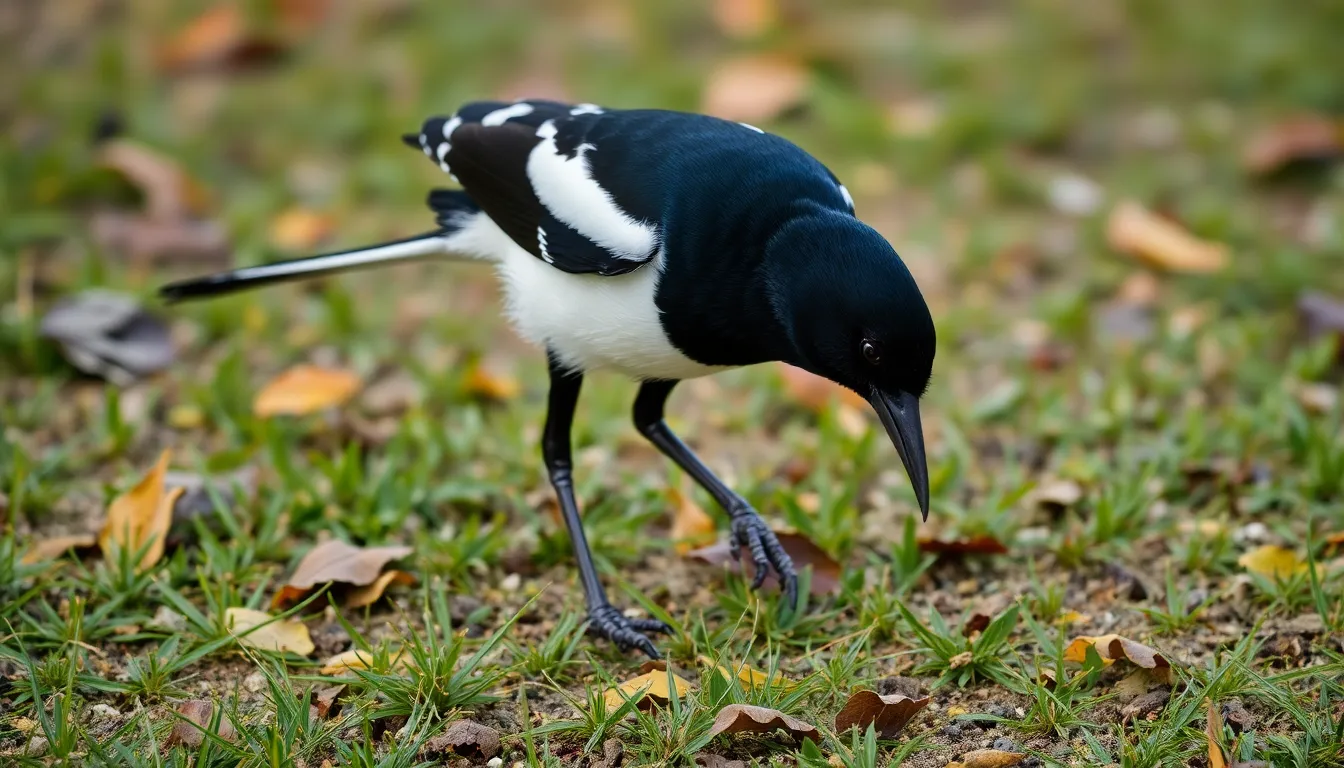
Magpies demonstrate remarkable adaptability in their eating habits, consuming a diverse array of foods that varies seasonally and by habitat availability. These intelligent birds adjust their diet based on environmental conditions and food abundance throughout the year.
Omnivorous Nature
Magpies consume both plant and animal matter, making them true omnivores with opportunistic feeding behaviors. Their diet includes insects like beetles, caterpillars, grasshoppers, and larvae during warmer months. Small mammals such as rodents, bird eggs, and nestlings provide protein sources, particularly during breeding season. Plant materials form a important portion of their diet, including berries, fruits, seeds, and grains.
Carrion represents another important food source, with magpies often scavenging roadkill and deceased animals. Urban magpies adapt their omnivorous habits by consuming human food scraps, pet food, and garbage. Seasonal variations affect their dietary preferences, with insects dominating summer feeding and plant matter increasing during autumn and winter months.
Foraging Techniques and Food Sources
Ground foraging comprises the primary hunting method for magpies, who use their powerful bills to probe soil and turn over debris. Their long legs enable them to walk and hop across various terrains while searching for invertebrates beneath the surface. Caching behavior allows magpies to store excess food in hidden locations, creating multiple food reserves they remember and revisit later.
Cooperative foraging occurs when magpie pairs or family groups work together to locate and capture prey. They employ different techniques including aerial hunting for flying insects and systematic ground searches in open areas. Agricultural fields provide abundant foraging opportunities where magpies consume crop pests, beneficial insects, and spilled grains.
| Foraging Method | Primary Food Sources | Seasonal Preference |
|---|---|---|
| Ground probing | Insects, larvae, worms | Spring, Summer |
| Scavenging | Carrion, food scraps | Year-round |
| Plant harvesting | Berries, seeds, fruits | Autumn, Winter |
| Aerial hunting | Flying insects | Summer |
| Caching | Various stored foods | Autumn preparation |
Territory defense during foraging ensures access to productive feeding areas, with established pairs maintaining exclusive rights to prime locations. Magpies demonstrate remarkable memory skills when relocating cached food items, often returning to exact hiding spots weeks after initial storage.
Cultural Significance and Folklore
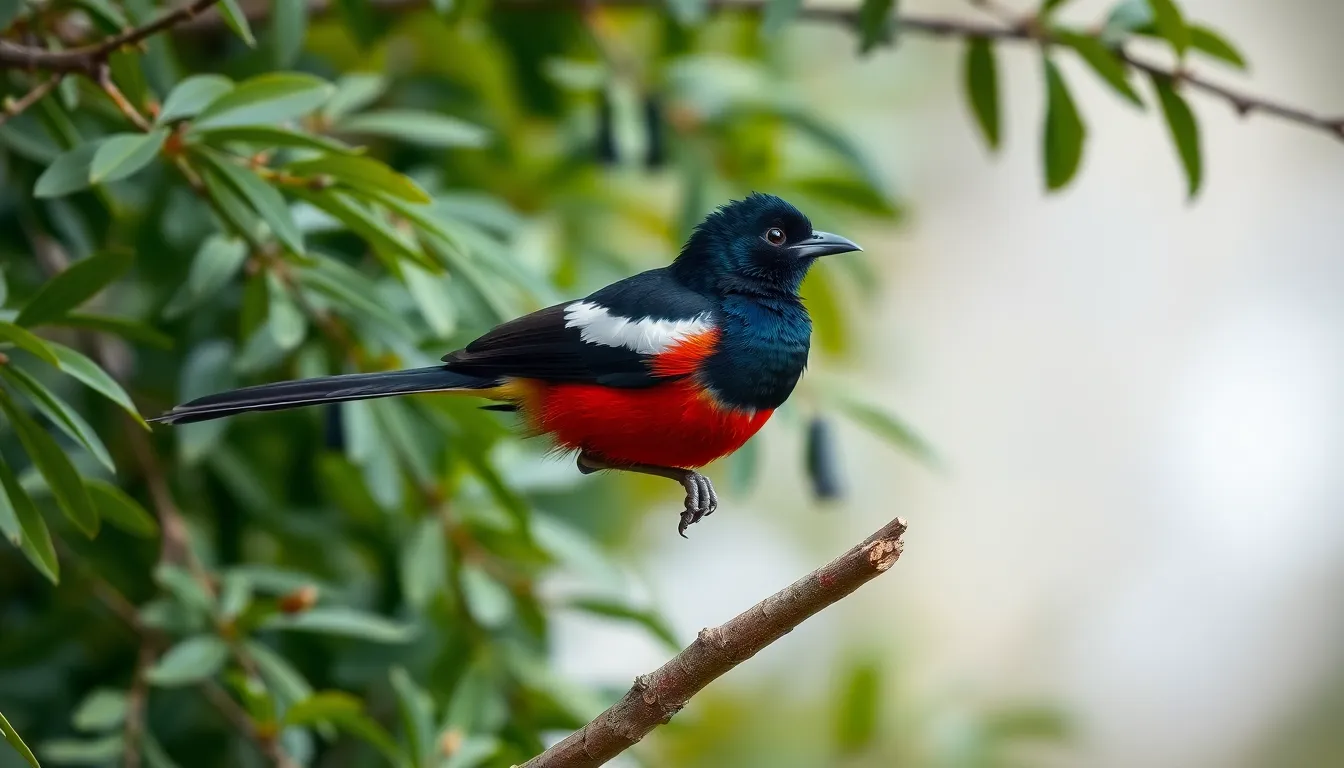
Magpies occupy profound positions in human cultural consciousness across multiple civilizations. These remarkable birds transcend their biological existence to become powerful symbols embedded in folklore traditions worldwide.
Symbolism Across Different Cultures
European traditions present magpies as complex symbols carrying both positive and negative connotations. In Celtic mythology, magpies represent prophecy and supernatural knowledge, while Germanic folklore associates them with witchcraft and otherworldly communication. Chinese culture elevates magpies as symbols of good fortune, joy, and marital happiness, with the bird’s arrival often interpreted as an omen of positive news or celebrations.
Korean folklore positions magpies as messengers between earthly and celestial realms. The traditional Korean folktale of the Weaver Girl and Cowherd features magpies forming bridges across the Milky Way to reunite separated lovers. Native American traditions vary among tribes, with some Plains tribes viewing magpies as trickster figures while others consider them sacred messengers carrying prayers to spirit worlds.
Australian Aboriginal cultures incorporate magpies into Dreamtime stories as creators and protectors. Various tribal groups across Australia associate magpie songs with territorial boundaries and seasonal changes, embedding these birds into complex spiritual and practical knowledge systems.
Common Myths and Superstitions
The famous “One for Sorrow” counting rhyme dominates European magpie superstitions, with variations existing across England, Scotland, and Ireland. Traditional verses assign different fortunes based on the number of magpies observed:
| Number of Magpies | Traditional Meaning |
|---|---|
| One | Sorrow or bad luck |
| Two | Joy or good fortune |
| Three | A girl or wedding |
| Four | A boy or birth |
| Five | Silver or wealth |
| Six | Gold or treasure |
| Seven | Secret or mystery |
British superstitions include the belief that saluting lone magpies prevents misfortune, while French traditions suggest magpies chattering near homes indicate incoming visitors or news. Italian folklore connects magpie behavior to weather predictions, claiming their flight patterns forecast storms or fair weather.
Modern urban legends attribute supernatural intelligence to magpies, with stories circulating about their ability to recognize individual humans and remember faces across generations. These contemporary myths often blend scientific observations about magpie intelligence with traditional folklore elements, creating new cultural narratives around these adaptable birds.
Magpie Birds as Pets
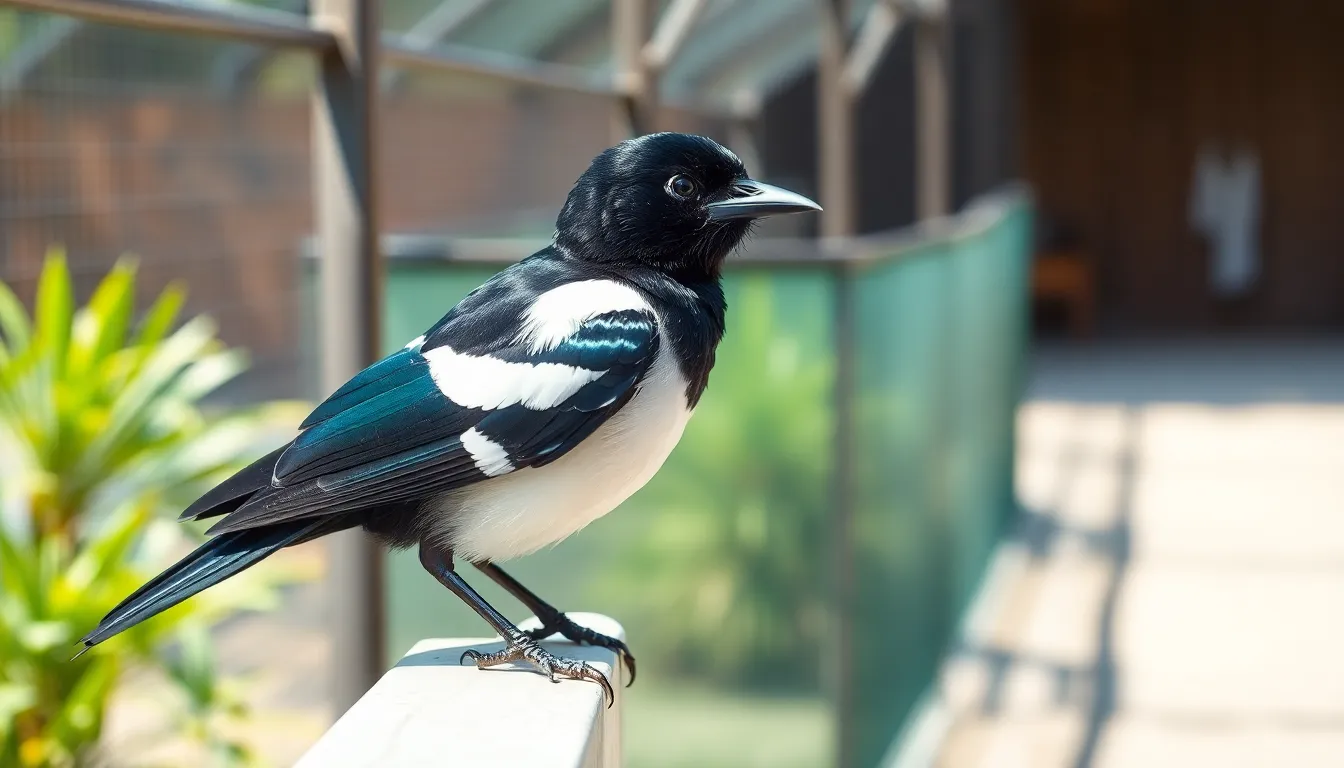
Magpie bird ownership presents important legal and practical challenges that potential owners must understand. These intelligent corvids require specialized care that differs dramatically from typical pet birds.
Legal Considerations
Most jurisdictions prohibit keeping magpie birds as pets due to federal wildlife protection laws. The Migratory Bird Treaty Act in the United States makes possession of native magpie species illegal without proper permits. European countries enforce similar regulations under the Wildlife and Countryside Act, protecting Eurasian magpies from capture and domestication.
Wildlife rehabilitation facilities and zoos obtain special permits for magpie care, but private individuals rarely qualify for these licenses. Australia maintains strict controls on native magpie ownership, with fines reaching $110,000 for illegal possession. Some states allow captive-bred exotic magpie species, but documentation requirements remain extensive.
International trade regulations under CITES restrict magpie imports and exports across borders. Prospective owners must research local wildlife laws before considering magpie acquisition, as violations carry criminal penalties.
Care Requirements and Challenges
Magpie birds demand complex care arrangements that exceed typical pet bird requirements. These corvids consume varied diets including insects, small mammals, eggs, and specialized pellets, requiring daily meal preparation of 6-8 different food types.
Housing magpie birds requires outdoor aviaries measuring minimum 20x10x15 feet to accommodate their natural flight patterns. Indoor confinement causes psychological stress and behavioral problems in these highly active birds. Temperature control becomes critical, as magpies tolerate ranges between 32-85°F but struggle in extreme conditions.
Social interaction needs prove challenging since magpies form complex hierarchical relationships with their species. Solitary magpie birds develop destructive behaviors, excessive vocalizations, and depression without proper socialization. Their intelligence requires mental stimulation through puzzle feeders, foraging opportunities, and environmental enrichment changes every 3-4 days.
Veterinary care presents another obstacle, as few avian veterinarians specialize in corvid medicine. Annual health examinations cost $200-400, while emergency treatments can exceed $1,000. Magpie birds live 15-20 years in captivity, representing a important long-term commitment.
Behavioral challenges include their natural curiosity leading to property destruction, cache hoarding throughout living spaces, and territorial aggression during breeding seasons. Their problem-solving abilities allow escape from standard enclosures, requiring specialized security measures.
Conservation Status and Threats
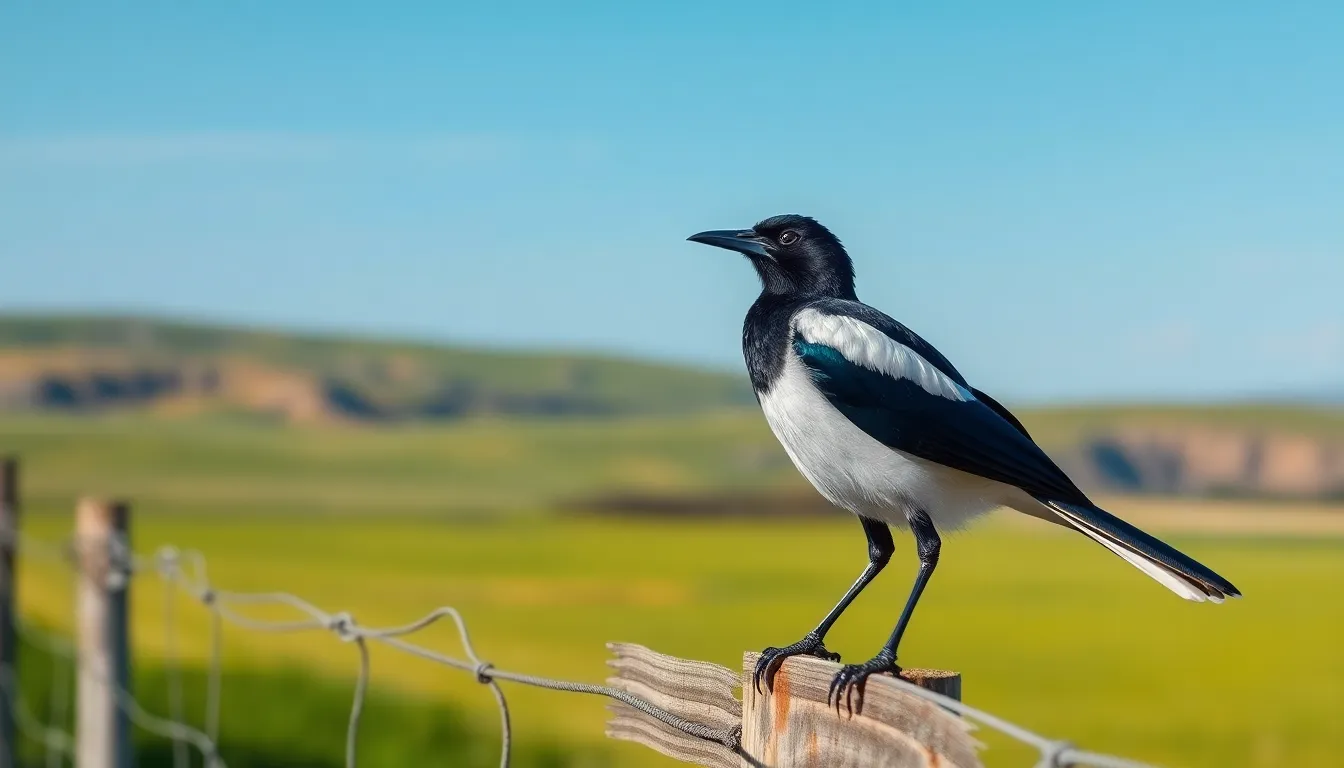
Magpie populations face varying conservation challenges across different regions, with some species thriving while others experience important declines. Current assessments reveal diverse population trajectories that reflect the complex relationship between these intelligent birds and changing environments.
Population Trends
Eurasian magpie populations remain stable across most of their European range, with the International Union for Conservation of Nature classifying them as Least Concern. BirdLife International reports approximately 46 to 228 million breeding pairs worldwide for this species. Regional variations show population increases in urban areas of Germany and the Netherlands, where magpies adapt successfully to city environments.
North American black-billed magpie numbers demonstrate regional stability in western territories, though localized declines occur in agricultural zones. The North American Breeding Bird Survey indicates a 0.7% annual decline from 1966 to 2019 in certain areas. Yellow-billed magpies face more serious conservation concerns, with populations restricted to California’s Central Valley experiencing habitat fragmentation pressures.
Australian magpie populations maintain stable numbers across the continent, benefiting from their adaptability to modified landscapes. State wildlife agencies classify them as secure species with no immediate conservation concerns. Some subspecies show population growth in suburban areas where they exploit new food sources and nesting opportunities.
Human Impact and Environmental Factors
Agricultural intensification poses the primary threat to magpie populations through habitat loss and pesticide use. Monoculture farming practices eliminate the diverse insect populations that magpies depend on for feeding their young. Pesticide applications reduce arthropod abundance by 72% in treated areas, directly impacting magpie reproductive success rates.
Urban development creates mixed outcomes for magpie conservation efforts. Cities provide year-round food sources and reduced predation pressure, supporting higher population densities in metropolitan areas. But, urban expansion fragments rural habitats and increases collision risks with vehicles and buildings.
Climate change affects magpie populations through altered precipitation patterns and temperature shifts. Extended drought periods in Australia reduce ground invertebrate availability, forcing magpies to modify foraging behaviors. European populations experience earlier breeding seasons as spring temperatures rise, potentially creating mismatches with peak insect abundance.
Human persecution continues in some regions where magpies are viewed as agricultural pests or threats to game birds. Shooting and trapping programs target magpies in areas with intensive livestock farming, though scientific evidence shows minimal impact on livestock productivity. Education programs emphasize the ecological benefits magpies provide through pest insect control and carrion cleanup.
Conclusion
Magpies truly stand out as some of nature’s most remarkable birds. We’ve explored how their extraordinary intelligence rivals that of primates while their complex social structures demonstrate sophisticated communication and cooperation. These adaptable creatures have successfully colonized diverse habitats across multiple continents.
From their striking appearance to their intricate cultural significance magpies continue to captivate both scientists and the general public. Their ability to thrive alongside human development while maintaining their wild behaviors makes them unique ambassadors for wildlife conservation.
Whether you’re observing them in your backyard or studying their behavior patterns magpies offer endless opportunities for discovery. We encourage everyone to appreciate these intelligent corvids and support conservation efforts that protect their habitats for future generations to enjoy.
Frequently Asked Questions
What makes magpies so intelligent compared to other birds?
Magpies rank among the most intelligent bird species, capable of recognizing themselves in mirrors, solving multi-step puzzles, and using tools. They demonstrate advanced problem-solving skills, can conduct elaborate funerals for their dead, and use over 20 distinct vocalizations for communication. Their cognitive abilities rival those of primates in many aspects.
How big do magpies typically get?
Magpies measure between 17 to 23 inches in length, with males typically weighing more than females. They have robust bodies featuring long graduated tails and powerful straight bills. Size variations exist across different species and regions, with North American black-billed magpies having longer tails relative to their body size compared to Eurasian magpies.
Where can magpies be found around the world?
Magpies are found across multiple continents with remarkable adaptability. Eurasian magpies span from western Europe to parts of North Africa, North American black-billed magpies inhabit western North America, and Australian magpies dominate Australia and southern New Guinea. They prefer semi-open landscapes with trees for nesting and open ground for foraging.
What do magpies eat in their natural habitat?
Magpies are omnivores with a diet that varies seasonally. They eat insects, small mammals, plant materials, and carrion. They employ various foraging techniques including ground probing, scavenging, and aerial hunting. Magpies also cache food for later use, demonstrating their impressive memory skills and cooperative foraging behaviors.
Is it legal to keep magpies as pets?
Most jurisdictions prohibit keeping magpies as pets due to wildlife protection laws. Even where legal, magpie ownership requires extensive care including specialized diets, large outdoor aviaries, and constant social interaction. Veterinary care is costly and specialized, making magpie ownership a significant long-term commitment with complex legal considerations.
What is the cultural significance of magpies in different cultures?
Magpies hold complex symbolism across cultures. In European traditions, they represent both good and bad fortune, while Chinese culture views them as symbols of joy and marital happiness. Korean folklore depicts them as messengers between realms, and Australian Aboriginal cultures incorporate them into Dreamtime stories. The “One for Sorrow” rhyme remains popular in Europe.
Are magpie populations currently threatened or endangered?
Conservation status varies by species. Eurasian magpies remain stable and are classified as Least Concern. North American black-billed magpies show localized declines in agricultural areas, while yellow-billed magpies face more serious challenges due to habitat fragmentation. Australian magpies maintain stable populations, benefiting from their adaptability to modified landscapes.
How do magpies communicate with each other?
Magpies use over 20 distinct vocalizations for communication, with specific calls serving various social functions including territorial warnings and alarm signals. They have complex social hierarchies and demonstrate sophisticated communication patterns. Their vocal repertoire includes calls for mating, territory defense, and coordinating group activities within their social structures.

